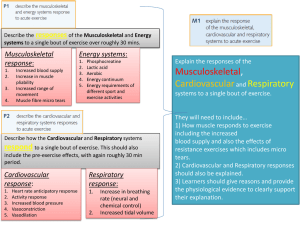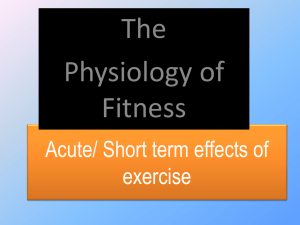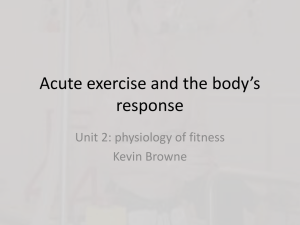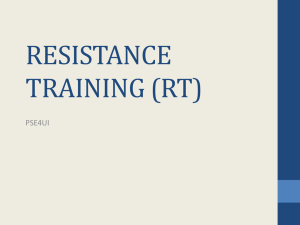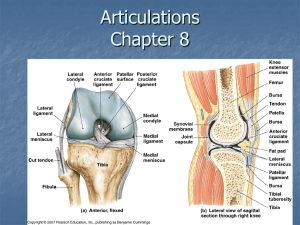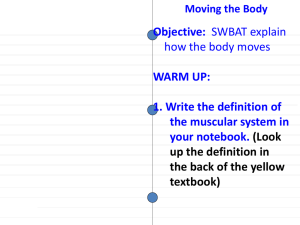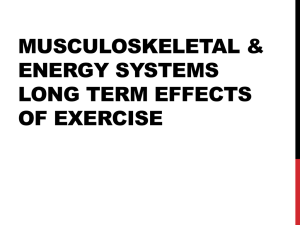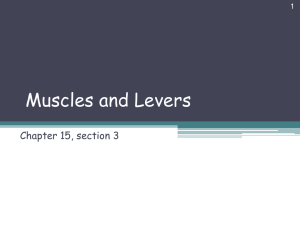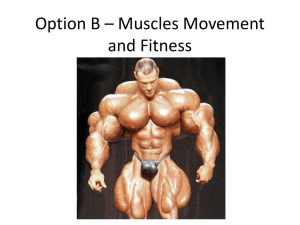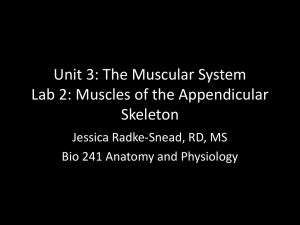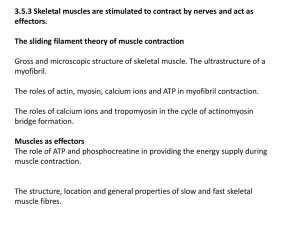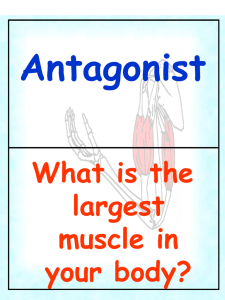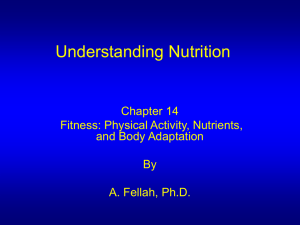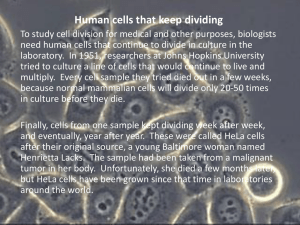Topic 1 PowerPoint
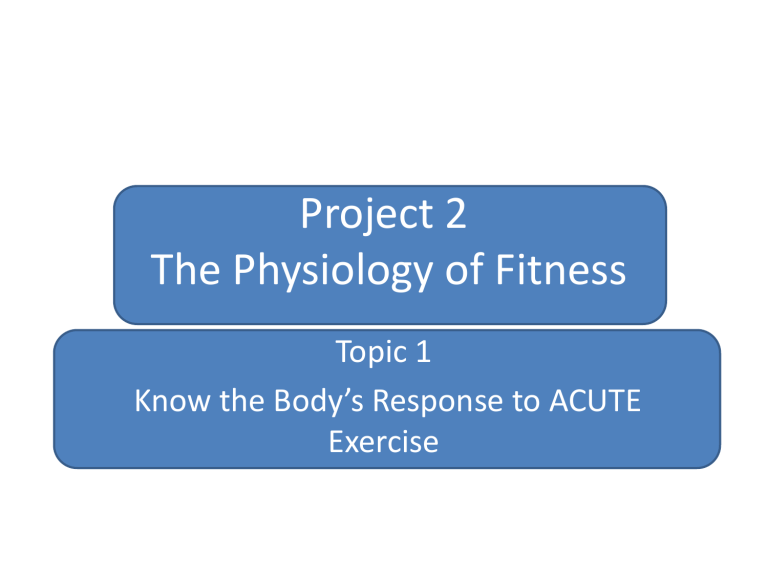
Project 2
The Physiology of Fitness
Topic 1
Know the Body’s Response to ACUTE
Exercise
“Know the Body’s Response to ACUTE
Exercise”
•
Musculoskeletal –
muscles, bones, ligaments etc
•
Cardiovascular –
heart, blood vessels, lungs etc
•
Respiratory – lungs, gas exchange etc
•
Energy Systems – fuel for energy
Musculoskeletal
• Increased Blood Supply to the Muscles
More blood in needed within the muscles and so blood from other body parts such as organs is reduced. This is known as “redistribution”.
• Increase in Muscle Pliability
(bendability)
More blood is pumped through the muscles
Excess heat is generated
Muscle tissue warms up
The warmer the muscle the more pliable it becomes
The muscle tissue is able to stretch to greater lengths without tearing
As muscle tissue warms up the rate of nervous impulses being sent increases
Heat therefore increases speed of nervous transmission!
Musculoskeletal
Increased Range of Movement
Increased production of synovial fluid
This is because exercise means our joints are moving quickly, so there needs to be more synovial fluid in the joints to allow this movement
The joints become warmer
The synovial fluid becomes thinner, making movement more efficient.
Increased movement and mobility of the joints:
As the joints get warmer there is an increased elasticity of tendons and ligaments
Muscle Fibre Micro Tears
During exercise, tiny tears called micro tears develop within the muscle fibres. Muscles when put under excessive stress such as lifting weights can cause small tears in the muscles called micro fibre tears. During rest from training/exercise muscle then repairs the tear. Muscle reacts to these micro tears by adding more proteins to the muscle, resulting in muscle growth. Micro tears are tiny and cause mild to moderate soreness and stiffness.
Cardiovascular
Heart Rate Anticipatory Response
• Before exercise even begins heart rate increases in anticipation. This is known as the anticipatory response. It is mediated through the releases of a neurotransmitters called epinephrine and norepinephrine also known as adrenaline and noradrenaline (from the adrenal glands)
Heart Rate Activity Response
• as we start to exercise our HR increases this is directly proportional to the increase in intensity until you are near exhaustion. As you approach this point your HR levels off, this is your HR max.
Cardiovascular
• Increased Blood Pressure
• At rest, a typical systolic blood pressure in a healthy individual ranges from 110-
140mmHg and 60-90mmHg for diastolic blood pressure.
• During exercise systolic pressure, the pressure during contraction of the heart
(known as systole) can increase to over 200mmHg and levels as high as 250mmHg have been reported in highly trained, healthy athletes (2).
• Diastolic pressure on the other hand remains relatively unchanged regardless of exercise intensity. In fact an increase of more than 15 mm Hg as exercise intensity increases can indicate coronary heart disease and is used as marker for accessing an exercise tolerance test.
• Vasoconstriction & Vasodilation
• When you exercise your face goes red!!! During exercise body temperature rises.
In order to disperse the heat, blood vessels expand (vasodilate) and move towards the surface. Blood being directed away form certain areas (e.g. organs so that blood can redirect to the muscles) vasoconstrict (get smaller).
Recap on Function of Respiratory System:
Respiratory Function During Exercise
• To provide a continuous and adequate supply of Oxygen to the tissues
• To enable the removal of
Carbon Dioxide from the body
• To assist in the maintenance of the acid-base (pH) of the body
• To assist in the control of body temperature
Respiratory
Increase In Breathing Rate
• The number of breaths per minute increases, due to neural & chemical influences
• Neural Control
– The rate & depth of breathing is controlled by the respiratory centre located in the Medulla
(brain stem) which send neural impulses to the respiratory muscles.
• Chemical Control
– Chemoreceptors are located around the body (mainly the bigger blood vessels such as the aorta). These are sensitive to chemicals such as O2, CO2 & pH (acid) levels within the blood. If they detect a change in normal levels, they stimulate the body to remove them by increased breathing.
– (pH changes due to lactic acid (release of hydrogen ions))
Increased Tidal Volume
– Volume taken in with each breath increases in an attempt to take in more O2 and dispose of more CO2
Energy Systems
•
phosphocreatine
•
lactic acid
•
aerobic
– energy continuum
– energy requirements of different sport and exercise activities
Duration vs. Intensity
All three energy systems contribute at the start of exercise but the contribution depends upon the individual, the effort applied or on the rate at which energy is used.
The following graph shows how the energy systems contribute to the manufacture of ATP over time when exercising at 100% effort.
The thresholds (T) indicate the point at which the energy system is exhausted - training will improve the thresholds times.
Recap of the Energy Systems.
The body uses different energy systems for each activity
• Quick movements-lasts a few seconds
• Reduced speed-lasts for several minutes
• Reduced intensity(50%)-lasts for several hours
Predominant Energy Pathways
• ATP (2-3 seconds)
• ATP-CP Energy System (8-10 seconds)
• Anaerobic Energy System (2-3 minutes)
• Aerobic Energy System (3 minutes +)
ATP is stored in small amounts, therefore the rest is stored as:
Eaten as… Broken down into… Stored as…
• Carbohydrates = Glucose = Glycogen (muscle & liver)
• Fats
• Protein
= Fatty Acids
= Amino Acids
= Body fat
= Growth, repair or excreted as waste
Fuel for Exercise:
• Anaerobic Energy System = Carbohydrates are the only fuel source
• With prolonged exercise, Carbohydrates are the first fuel choice, as exercise continues, FAT becomes predominant :
• As exercise intensity
, energy supplied by Carbohydrates
• As duration
, energy supplied by fat
• Protein is not a main fuel source except in an emergency :
• As glycogen
, energy supplied by protein
• Each system plays an important role in energy production:
• All energy systems are “on” at all times
• This gives us a variety of movements
• The systems interact to supply Energy for the activity
• So, there is always a trade-off between exercise intensity and duration:
• High intensity (fast, hard) requires a lot of
• glycogen so duration has to be short
• Low-intensity (slow, easy) requires little
• glycogen so duration can be long
Different Sports using Different Energy Systems
Sport
Basketball
Fencing
Field events
Golf swing
Gymnastics
Hockey
Distance running
Rowing
Skiing
Soccer
Sprints
Swimming 1.5km
Tennis
Volleyball
ATP-CP and LA % LA-Aerobic
%
20
33
50
90
10
80
50
10
60
90
90
95
70
80
30
33
20
10
20
15
20
20
20
10
10
5
20
5
Aerobic
%
20
70
10
15
50
33
30
5
30
70
Table adapted from Fox E. L. et al, The Physiological Basis for Exercise and
Sport, 1993
